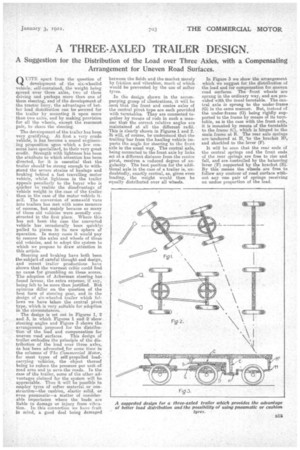A THREE-AXLED TRAILER DESIGN.
Page 15

If you've noticed an error in this article please click here to report it so we can fix it.
A Suggestion for the Distribution of the Load over Three Axles, with a Compensating Arrangement for Uneven Road Surfaces.
UlTE apart from the question of development of the six-wheeled vehicle, self-contained, the weight being spread over three axles, two of them driving and perhaps more than one of them steering, and of the development of the tractor lorry, the advantages of better load distribution can bee secured for the trailer by mounting it upon more than two axles, and by making provision for all the wheels, except the rearmost pair, to sharethe steering:
The development of the trailer has been very gratifying. At first a very crude vehicle, it has become a sound engineering proposition upon which a few concerns have specialized, to their very great credit. Strength with lightness has been the attribute to which attention has been directed, for it is essential that the trailer shouldbe strong enough to withstand the severe strains of haulage and braking behind a fast travelling meter vehicle, whilst lightness in the trailer appeals peculiarly to the buyer who is quicker to realize the disadvantage of vehicle weight in the case of the trailer than in the case ef the motor vehicle itself. The conversion of some-sold vans into trailers has met with some measure of success, but mainly because so many of these old vehicles were soundly constructed in the first place. Where this has not been the case the converted vehicle has occasionally been quieklyr pulled to pieces in its new sphere of operation. In many eases it would pay to remove the axles and wheels of these old vehicles, and to adopt the system to which we propose to draw attention in this article.
Steering and braking have both been Use subject of careful thought and design, and recant trailer productions have shown that the warmest critic could find no cause for grumbling on these scores. The adoption of Ackerman steering has found favour, the extra expense, if any, being felt to be more than justified. But opinions differ Oa the question of the best form of steering gear, and in the design of six-wheeled trailer which follows we have taken the central pivot type, which is very suitable for adoption in the circumstances.
The design is set out in Figures 1, 2 and 3, in which Figures 1 and 2 show steering angles and Figure 3 shows the arrangement proposed for the distribution of the load and compensation for
uneven road surfaces. This design of trailer embodies the principle of the-distribution of the load over three axles, as has been advocated_ for some time in the columnsof The. Coninzercial Motor, for most types of self-propelled loadcarrying v.ehieleS, the object thereof being to reduce the pressure per unit of road area and to save-the roads. In the case of the trailer' some of the other ael4 vantages claimed for the system will be appreciable. Thus it will be possible to employ tyres of softer material or construction—the cushion, elastic solid, or even pneumatic—a matter of considerable importance where the loads are liable to damage or injury from vibration. In this connection we have fruit in mind, a good deal being damaged
between the fields and the market merely by friction and vibration, much of which would be prevented by the use of softer tyres.
In the design shown in the accompanying group of illustrations, it will be seer that the front and centre axles of the central pivot type are each provided with turntables. They are connected together by means of rods in such a manner that the correct relative angles are maintained at all the different radii. This is clearly shown in Figures 1 and 2. It will, of course, be understood that the trailing bar from the hauling vehicle imparts the angle for steering to the front axle in the usual .way. The central axle, being connected to the front axle by links set at a different distance from the centre pivot, receives a reduced degree, of angularity. The best position for the additional axle in the case of a trailer is, undoubtedly, exactly central, as, given even loading, the weight would then be equally distributed over all wheels.
In Figure 3 we show the arrangement which we suggest for the distribution of the load and for compensation for uneven road surfaces. The front wheels are sprung in the ordinary way, and are provided with the usual turntable. The central axle is sprung to the under-frame • (G) in the same manner. But, instead of the under-frame (0) being rigidly supported to the frame by means of its turntable, as is the case with the front axle, it is mounted by means of the turntable to the frame (-C), which is hinged to the main frame at B. The rear axle springs are 'anchored at H, to the bracket H1, and shackled .to the lever (F).
It will be seen that the rear ends of the central springs and the front ends of the rear springs are free to rise and fall, and are cent-rolled by the balancing lever (F) supported by the bracket (E). By this means the wheels are free to follow any contour of road surface without any one pair of springs receiving an undue proportion of the load.




























